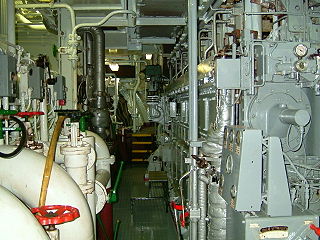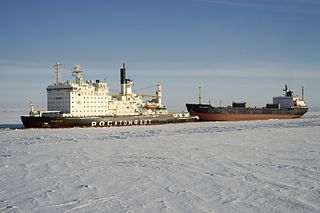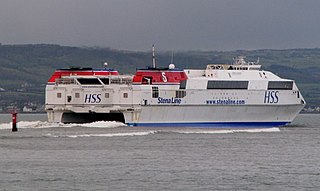Related Research Articles

A gas turbine, also called a combustion turbine, is a type of continuous and internal combustion engine. The main elements common to all gas turbine engines are:

NS Savannah was the first nuclear-powered merchant ship. She was built in the late 1950s at a cost of $46.9 million and launched on July 21, 1959. She was funded by United States government agencies. Savannah was a demonstration project for the potential use of nuclear energy. The ship was named after SS Savannah, the first steamship to cross the Atlantic ocean. She was in service between 1962 and 1972 as one of only four nuclear-powered cargo ships ever built.

On a ship, the engine room (ER) is the compartment where the machinery for marine propulsion is located. To increase a vessel's safety and chances of surviving damage, the machinery necessary for the ship's operation may be segregated into various spaces. The engine room is generally the largest physical compartment of the machinery space. It houses the vessel's prime mover, usually some variations of a heat engine. On some ships, there may be more than one engine room, such as forward and aft, or port or starboard engine rooms, or may be simply numbered.

Combined diesel and gas(CODAG) is a type of propulsion system for ships that need a maximum speed that is considerably faster than their cruise speed, particularly warships like modern frigates or corvettes.

Combined diesel-electric and gas (CODLAG) is a modification of the combined diesel and gas propulsion system for ships. A variant, called the combined diesel-electric or gas (CODLOG) system, contains the same basic elements but will not allow simultaneous use of the alternative drive sources.

A turbo-electric transmission uses electric generators to convert the mechanical energy of a turbine into electric energy and electric motors to convert it back into mechanical energy to power the driveshafts.

Folsom Powerhouse State Historic Park is a historical site preserving an 1895 alternating current (AC) hydroelectric power station—one of the first in the United States.

Sapphire Princess is a cruise ship owned by Princess Cruises that entered service in 2004 as the sister ship of Diamond Princess. At the time she was one of the world's largest cruise ships, with a capacity of 2,670 passengers and is the second Gem-class ship built by Princess Cruises. Sapphire Princess was christened on 10 June 2004, in Seattle—the first cruise ship ever to be christened in that port.

Marine propulsion is the mechanism or system used to generate thrust to move a ship or boat across water. While paddles and sails are still used on some smaller boats, most modern ships are propelled by mechanical systems consisting of an electric motor or engine turning a propeller, or less frequently, in pump-jets, an impeller. Marine engineering is the discipline concerned with the engineering design process of marine propulsion systems.

Taymyr is a shallow-draft nuclear-powered icebreaker, and the first of two similar vessels. She was built in 1989 for the Soviet Union in Finland, at the Helsinki Shipyard by Wärtsilä Marine, by order of the Murmansk Shipping Company. Her sister ship is Vaygach.

Vaygach is a shallow-draught nuclear-powered icebreaker. She was built in 1989 for the Soviet Union by Wärtsilä Marine Helsinki Shipyard in Finland by order of the Murmansk Shipping Company. Her sister ship is Taymyr.

Luna is a historic tugboat normally berthed in Boston Harbor, Massachusetts. Luna was designed in 1930 by John G. Alden and built by M.M. Davis and Bethlehem Steel. She is listed on the National Register of Historic Places and is a U.S. National Historic Landmark. In 1985, the Luna was designated as a Boston Landmark by the Boston Landmarks Commission.

One World Karadeniz is a former high-speed ferry that operated Stena Line's Holyhead–Dún Laoghaire service between Great Britain and Ireland until 2015. It is a member of the HSS 1500 class of high-speed ferries introduced and developed by Stena Line from 1996 onwards. The HSS 1500 class vessels became the largest catamarans in service in the world.

Stena Voyager was a high-speed ferry owned by Stena Line which used to operate on their Belfast–Stranraer service. It was a member of the HSS 1500 class of high-speed ferries developed and introduced by Stena Line from 1996 onwards.

The E-Ship 1 is a RoRo cargo ship that made its first voyage with cargo in August 2010. The ship is owned by the third-largest wind turbine manufacturer, Germany's Enercon GmbH. It is used to transport wind turbine components. The E-Ship 1 is a Flettner ship: four large rotorsails that rise from its deck are rotated via a mechanical linkage to the ship's propellers. The sails, or Flettner rotors, aid the ship's propulsion by means of the Magnus effect – the perpendicular force that is exerted on a spinning body moving through a fluid stream.
Integrated electric propulsion (IEP) or full electric propulsion (FEP) or integrated full electric propulsion (IFEP) is an arrangement of marine propulsion systems such that gas turbines or diesel generators or both generate three-phase electricity which is then used to power electric motors turning either propellers or waterjet impellors. It is a modification of the combined diesel-electric and gas propulsion system for ships which eliminates the need for clutches and reduces or eliminates the need for gearboxes by using electrical transmission rather than mechanical transmission of energy, so it is a series hybrid electric propulsion, instead of parallel.
Union Rotoiti was a large roll-on/roll-off vessel operated on the trans Tasman route by the Union Steam Ship Company of New Zealand (USSCo.). Along with her sister ship Union Rotorua, she was unusual in that she originally had turbo-electric transmission.

Sisu was a Finnish state-owned icebreaker. Built in 1939 at Wärtsilä Hietalahti Shipyard in Helsinki, she was one of the world's first diesel-electric icebreakers. In addition to icebreaking duties, she served as a submarine tender for the Finnish Navy during the summer months until the end of the Continuation War.

SS Otaki was a New Zealand Shipping Company refrigerated cargo steamship that was built in Scotland in 1908 and sunk by a German merchant raider in 1917.

SS Rotorua was a New Zealand Shipping Company steam ocean liner and refrigerated cargo ship that was built in Scotland in 1910 and sunk by a U-boat in 1917.
References
- ↑ "Ship's cost seen as a 'disaster'". The Sydney Morning Herald . Retrieved 6 February 2016.
- 1 2 3 "Investigation: 61 – Fire on board the Union Rotorua". www.atsb.gov.au. Australian Transport Safety Bureau. Retrieved 6 February 2016.
- 1 2 Taylor, GR (October 1976). "RO/RO Ships - State of the Art in Australasia". Marine Technology. 13 (4). Retrieved 7 February 2016.
- ↑ Taonga, New Zealand Ministry for Culture and Heritage Te Manatu. "Keyworth, Andrew Stanley". www.teara.govt.nz. Retrieved 6 February 2016.
- ↑ Stern, Eric; Newlove, Lindy; Svedin, Lina (1 January 2003). Auckland Unplugged: Coping with Critical Infrastructure Failure. Lexington Books. ISBN 9780739107744.